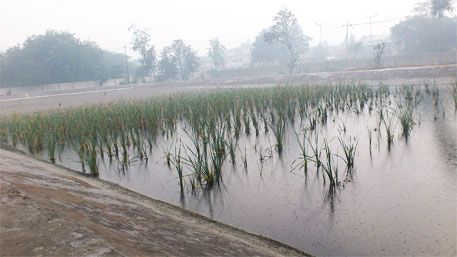Wetlands to Help Treat Drains
Published on by Water Network Research, Official research team of The Water Network in Government
As Delhi government starts work to implement the ambitious Yamuna turnaround plan, attempts are simultaneously being made to address the pollution in the city's three major drains.

To start with, Delhi Jal Board (DJB) has recently appointed a consultant to prepare a detailed plan for an 8-km stretch of the supplementary drain which will be treated through a network of constructed wetlands.
Senior officials said that a similar network of wetlands was also being planned for Yamuna upstream of Wazirabad. "We are looking at an 8-km stretch of the supplementary drain from Bhalswa lake to Sur Ghat where it joins the Najafgarh drain.
This will be a pilot project which, if successful, will set the trend for cleaning all other water bodies. It will also show the correct way of treating sewage and handling a drain," said an official.
DJB will be using constructed or floating wetlands for treating sewage in the drain, as opposed to a sewage treatment plant (STP). This, said an official, is an inexpensive and natural system for waste water treatment. "Delhi is short of land and it is not possible to install highly expensive STPs at every step. We need to look at inexpensive mechanisms and wetlands will be beneficial in multiple ways," said the official.
The four-pronged approach to cleaning the drain will be through addressing the problem of contaminated water, solid waste, sludge and septage. The supplementary drain, along with Najafgarh and Shahdara drains, contributes the maximum pollution to Yamuna within city boundary. Construction of this drain started in 1982 after the Najafgarh drain failed to handle the flood waters of late 1970s.
At present, a mammoth task of supplementing all three drains with interceptors is taking place. These interceptor drains are expected to ensure no untreated water reaches Yamuna by trapping all small drains and taking the sewage to STPs before discharging.
In 2014, NGO FORCE experimented with the constructed wetland system for treating sewage in a mining pit in Rangpuri Pahari, where it installed a series of natural filters such as reed, coir, bamboo and jute meshes.
Source: The Times of India
Media
Taxonomy
- Biological Treatment
- Wetlands
- Sewage
- Water & Wastewater
- Wetlands
- Sewage & Allied Waste
- India
1 Comment
-
Delhi Govt and DJB first must stop flow of raw sewage/ Untreated effluents coming in to Delhi state from neighbouring states and seek legal enforcement of suitable treatment of influents as neighbouring states do have land resources and legal obligations. Rather than planning for compact STPs with full accountability for treated effluent Waste water, it is flawed logic to say that Land is costly, so, Bio Remediation by Floating Reed bed shall be attempted as low cost intervention. STPs take much lesser space while huge land area shall have to be brought under Reed Beds and Govt. shall have no control on Reed bed Lands harbouring pathogen carriers or disease vectors besides foul smelling gases getting generated and spreading in the localised environment. It also has potential of allowing Heavy metals and toxins percolating deep into u/g aquifers isolated or connected to River systems. A rethink is required. Why can DJB adopt more safe and lower economic cost options rather than pulling wool over its eyes by accepting and propagating twisted technical logic.
2 Comment replies
-
Thanks Mathew. Authorities must rethink and not waste time and resources in options which do not address the real requirements and are likely to allow continuation of permanent damage to aquifers and habitat around. All technological innovations should be deployed. Even before a Consultant is awarded a job to present a plan, how can authorities comment in favour of any option?
-
I find it very hard to imagine what a reed bed treatment system for Delhi would be like for all the reasons you have mentioned Lokesh! These systems also require some maintenance but the land area required would be enormous.
-